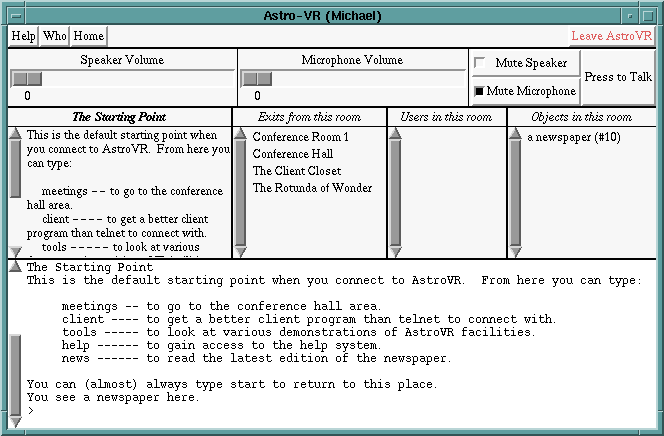- Places:

Network
|
 |
Jupiter is the name of an advanced MOO client by researchers at Xerox/PARC, notably Pavel Curtis, David Nichols, and Michael Dixon. Just to confuse the issue a little, 'Jupiter' also refers to the protocol used by this client to communicate with the MOO, and to a restricted-access MOO server which is Jupiter client-savvy and was used (among other things) to conduct meetings between Xerox's American and European offices. Throughout the rest of these pages, we will use the term 'Jupiter' to refer exlusively to the client.
To put Jupiter's accomplishments in perspective, remember that MOO interactions are traditionally text-based. A typical session might consist of text such as
The Coat Closet
The closet is a dark, cramped space. It appears to be very crowded
in here;
you keep bumping into what feels like coats, boots, and other
people
(apparently sleeping). One useful thing that you've discovered
in your
bumbling about is a metal doorknob set at waist level into what
might be a
door.
Blue_Guest teleports out.
X-Bunny [to Teal_Guest]: Kay then, is there anything I can do?
Darcalus perks up his ears,sniffs the air and then leaves
(this is an excerpt from an actual LambdaMOO session)
Conversations, research, and development are all possible through a command-line interface, but the lack of a graphical user interface makes for a steep learning curve and also severely limits the depth of immersion in these virtual worlds.
With Jupiter, a typical login session might look like this:

(this is an excerpt from an actual AstroVR session)
Jupiter provides a basic GUI toolkit, enabling users to create their own custom interfaces or (if they lack the motivation or access priveleges) to use the default interface(s) designed by the server administrators.
Another feature sorely lacking in a text-only world is the wealth of multimedia, increasingly popular thanks to innovative CD-ROM titles and the ubiquitous World Wide Web. Images, sound, and video need not be mere Hollywood glitz -- they can add depth and content to computer-mediated communication. Jupiter supports multicast audio and video (without any modifications to the MOO server). In my experience, video is of minimal use (especially because it is a bandwidth hog and broadcasting it requires special hardware), but real-time audio significantly enhances a communication. Speaking messages to one another instead of typing them is like talking on a telephone instead of sending a fax. Both have their purposes, and together they provide an almost complete communications solution.
The third feature of Jupiter is its ability to invoke and direct client-side applications in response to server directives. When combined with Jupiter's other features, this means that users can share data and processing power over the network through the MOO, and power users can construct custom interfaces to pre-existing software packages.
Although no one of these capabilities is especially earth-shattering -- many other collaboration and teleconferencing tools have come along since 1994 -- when added to (previously text-only) virtual realities such as MOO, they are quite powerful indeed.
Unfortunately, Jupiter was never publicly released as anticipated. Instead, the members of the Jupiter project team have left Xerox to form their own company, PlaceWare, and are now pursuing somewhat different, though related, goals. [Ed. note: In January, 2003, Microsoft acquired PlaceWare and has since incorporated the technology into Microsoft Office LiveMeeting.]